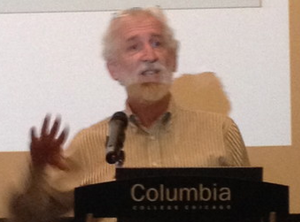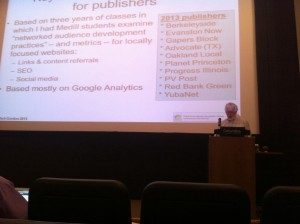The LION Summit 2013 finished Oct. 5, with a keynote speech from Steven Waldman, which tied together themes that ran throughout the entire conference. He talked about current problems and gaps in the news industry, as well as what the industry could become if these hurdles are cleared.
The Local Independent Online News Publishers association held its first annual conference to bring together entrepreneurs in the online news industry. Brandy Tuzon Boyd, creator of “The Natomas Buzz,” is on both the organization’s board of directors and the LION Summit Planning Committee.
“For me, coming to the summit serves two purposes,” she said. “The first is just the opportunity to network and connect with my peers… and then the second is just the opportunity to learn from each other.”
Steven Waldman, senior advisor to the Chairman of the Federal Communications Commission, was recently lead writer on the major FCC report “The Information Needs of Communities.” He encouraged the audience of independent media creators to think of themselves as more than rugged individuals.
“I hate to break the bad news, but you are a part of a movement — an important one,” he said.
Waldman said publishers should explore network business models that have helped large corporations, public radio and television.
“Part of how they have succeeded is being intelligent about shared services,” he said. Shared services are a way for businesses to focus on things that need to be done at a local level, while spreading the costs on other things.
Waldman stressed that the need for local, independent reporting is only growing while print media continues to shrink; because media contracts, anfd no one is filling the gap. This poses many problems towards local accountability reporting.
“Accountability is important at all levels of government, but especially on the local level where the major news media don’t have the time to focus their resources,” said Thom Rae, creator of “La Grange Today.” He said that local governments are often prone to waste.
“When you get to local elected officials in small villages – those are not jobs – they’re positions that citizens who hold other jobs do on their part time,” Rae said. “As a result they’re not necessarily all that well-versed in a lot of different laws and regulations that they have to deal with.”
Waldman said he was disappointed that local television news hasn’t done more to fill the gaps left by dwindling print media. He cited a study by The Norman Lear Center that found stations the Los Angeles market dedicated, on average, just over a minute to local news.
Another problem Waldman discussed was the growing need for more reporters.
“We don’t actually need as many reporters as we used to have,” he said. “Any reporter today can have a bigger impact individually than a reporter 20 years ago, but we still have too few.”
Suzanne McBride, co-creator and editor of “Austin Talks” also weighed in.
“If you compare how many people were working as paper, TV and radio reporters 20 to 30 years ago versus how many there are today—it’s not even half the number,” McBride said. “We have a lot of these hyper-local websites from LION and elsewhere who have started to cover local news in recent years, but in no way is that going to make up for that.”
Waldman said nonprofit media agencies need to step in and fill the gaps of the changing media landscape because the commercial sector probably never will. It’s the tech giants of today’s economy that should put money into the nonprofit media sector, Waldman said, just like the titans of industry in the 19th century did.
“It’s great that these gaps in the media sector are being plugged by the fortunes of the industrial era,” he said. “But, how about some of the fortunes of the digital era help to play a role here.”
To illustrate his point, Waldman said that if you take the profits from Apple, Google, Verizon and AT&T since 2010 and added them up they would total to $13 billion. Two percent of this, if applied to the nonprofit media sector, would completely fill all the gaps that have been created by the contraction of news organizations, Waldman said.
While the current state of media is facing many challenges, Waldman is convinced that if effective, hyper-local news gathering can be successfully integrated into a new media model, we could have the best news system yet.
“You’re doing this at an incredible moment that is both bleak and exciting at the same time.”







Be First to Comment